I have often spoken about the importance of term insurance and why other insurance-cum-investment plans are not a good idea.
But, the moment you mention a term plan to an agent, they will tell you why you need an endowment plan or a Unit Linked Insurance Plan, ULIP.
Sure, ULIPs may be the hottest product and may have given 30% per annum in the past three years. But does that mean it is best suited to your needs?
Get it right
Term insurance is the cheapest and most basic form of life insurance.
It provides the policyholder with protection only. If the policyholder dies within the specified number of years (the term, say 20 years), his nominee gets the sum insured. If he lives beyond the specified period, the policyholder gets nothing. In this case, the money (premium) that s/he pays during all this 20 years gives her/him no returns.
Endowment combines both saving and protection.
You are given a life cover just like term insurance. If you die during this period, your beneficiary will get whatever amount you are insured for.
Unlike a term insurance cover, if you live, an amount will be paid to you on maturity of the plan.
This kind of policy combines savings (because money is given to you on maturity) with some protection (your nominee gets an amount if you die).
A Money Back policy combines saving and protection as well but it gives back money to the policyholders at different points in time, usually 4 years. To elaborate, money back policy will give you 20% of the Sum Assured after first 4 years, next 20% after 8 years and the remaining 20% on maturity along with accumulated bonuses.
Returns that can be expected from Money Back and Endowment policies are to the tune of 5-6%. You can see this from the various bonus announcements that LIC has been making for the last few years.
On the other hand, a ULIP is like a mutual fund combined with insurance. So you have units here just like a mutual fund. Part of the money you pay by way of premium goes to provide you with an insurance cover and a part of it are invested like a mutual fund.
How term insurance scores
Let's say that you have calculated your insurance need at Rs one crore (Rs 10 million) as of today.
So you take an endowment cover of this amount and decide to pay a premium of Rs 3,00,000 to Rs 5,00,000 per annum for this.
But, if you take a term life cover, you will end up paying just Rs 30,000 to Rs 35,000 per annum as premium for the same amount of Sum Assured.
There are tremendous benefits of taking a pure life insurance cover, that is, a term insurance.
You pay much less by way of premium. Over the years, the present value of your premium will fall even more, that is, you may earn more after five years than you are earning now. Rs 30,000 today will be worth much less 16 years down the road and will not pinch your pocket that much.
You have the right kind and amount of insurance and have not compromised by being underinsured. Normally, people make a mistake in taking an endowment cover where the premium is higher but the cover is lower (that is the policy holder is under-insured).
You get the full tax benefit for your premium (the Rs 3,00,000 premium that you need to pay for an endowment policy is over and above the Rs 1,00,000 limit set under Section 80C). Besides most of the people can get 80C benefits through Employees Provident Fund (EPF), Public Provident Fund (PPF), Equity Linked Saving Scheme (ELSS) and home loan principal.
With the term life cover, you can evaluate if you need to continue with the same cover (Rs one crore) few years down the line. As you accumulate wealth, your need for insurance goes down. But in an endowment plan, you will have to pay till the last premium date which could be say 5 years from the day you decide to reduce the cover needed by you.
With an endowment or money back plan, most of the bonuses paid are on the face value of the policy and are not compounded returns. So, if your policy were for Rs 1,00,000, a 10% bonus would be 10% on this amount, that is Rs 10,000. Even though the amount due to you would be, say, Rs 2,00,000, you will get 10% of Rs 1,00,000, not Rs 2,00,000.
In conclusion: You are much better off buying a term plan and investing the rest in a risk-free offering such as the PP Fund or ELSS depending on your tolerance to risk.
Amar Pandit is a certified financial planner and runs the Mumbai-based firm My Financial Advisor.






 © 2025
© 2025